JEEP WRANGLER UNLIMITED 2020 Owner handbook (in English)
Manufacturer: JEEP, Model Year: 2020, Model line: WRANGLER UNLIMITED, Model: JEEP WRANGLER UNLIMITED 2020Pages: 330, PDF Size: 9.16 MB
Page 121 of 330
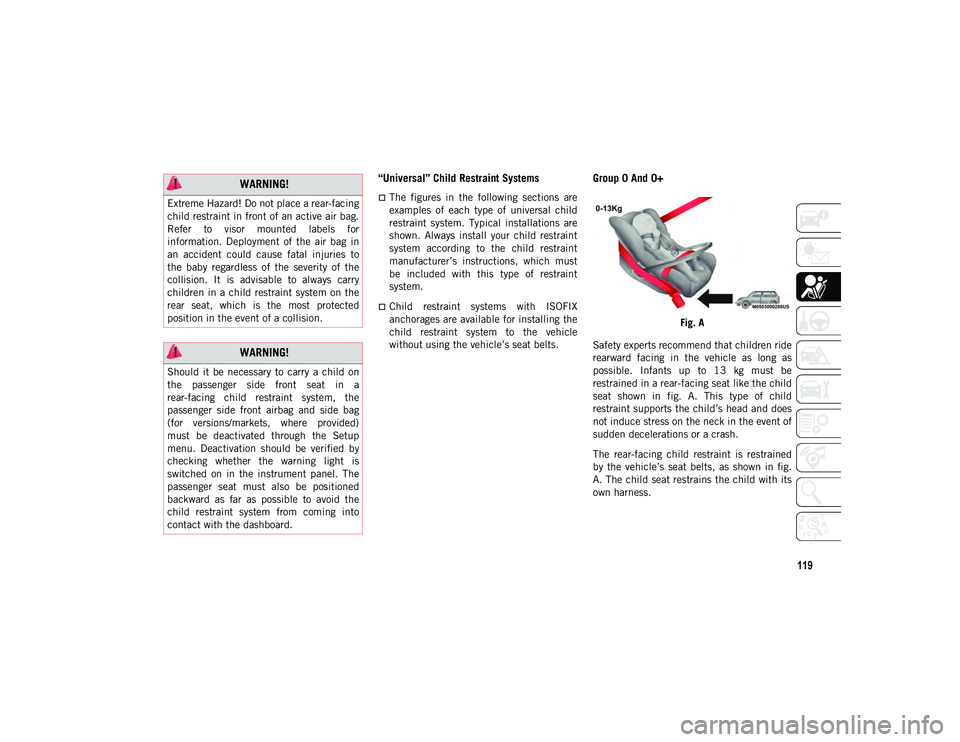
119
“Universal” Child Restraint Systems
The figures in the following sections are
examples of each type of universal child
restraint system. Typical installations are
shown. Always install your child restraint
system according to the child restraint
manufacturer’s instructions, which must
be included with this type of restraint
system.
Child restraint systems with ISOFIX
anchorages are available for installing the
child restraint system to the vehicle
without using the vehicle’s seat belts.
Group 0 And 0+
Fig. A
Safety experts recommend that children ride
rearward facing in the vehicle as long as
possible. Infants up to 13 kg must be
restrained in a rear-facing seat like the child
seat shown in fig. A. This type of child
restraint supports the child’s head and does
not induce stress on the neck in the event of
sudden decelerations or a crash.
The rear-facing child restraint is restrained
by the vehicle’s seat belts, as shown in fig.
A. The child seat restrains the child with its
own harness.
WARNING!
Extreme Hazard! Do not place a rear-facing
child restraint in front of an active air bag.
Refer to visor mounted labels for
information. Deployment of the air bag in
an accident could cause fatal injuries to
the baby regardless of the severity of the
collision. It is advisable to always carry
children in a child restraint system on the
rear seat, which is the most protected
position in the event of a collision.
WARNING!
Should it be necessary to carry a child on
the passenger side front seat in a
rear-facing child restraint system, the
passenger side front airbag and side bag
(for versions/markets, where provided)
must be deactivated through the Setup
menu. Deactivation should be verified by
checking whether the warning light is
switched on in the instrument panel. The
passenger seat must also be positioned
backward as far as possible to avoid the
child restraint system from coming into
contact with the dashboard.
2020_JEEP_JL_WRANGLER_UG_RHD_UK.book Page 119
Page 122 of 330
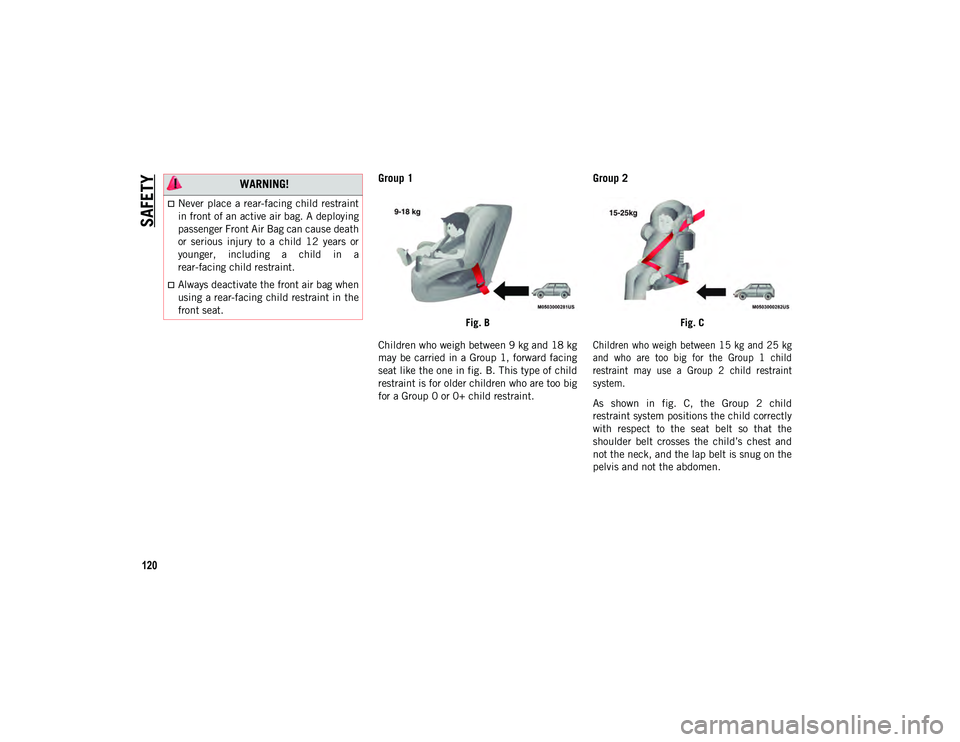
SAFETY
120
Group 1
Fig. B
Children who weigh between 9 kg and 18 kg
may be carried in a Group 1, forward facing
seat like the one in fig. B. This type of child
restraint is for older children who are too big
for a Group 0 or 0+ child restraint.
Group 2
Fig. C
Children who weigh between 15 kg and 25 kg
and who are too big for the Group 1 child
restraint may use a Group 2 child restraint
system.
As shown in fig. C, the Group 2 child
restraint system positions the child correctly
with respect to the seat belt so that the
shoulder belt crosses the child’s chest and
not the neck, and the lap belt is snug on the
pelvis and not the abdomen.
WARNING!
Never place a rear-facing child restraint
in front of an active air bag. A deploying
passenger Front Air Bag can cause death
or serious injury to a child 12 years or
younger, including a child in a
rear-facing child restraint.
Always deactivate the front air bag when
using a rear-facing child restraint in the
front seat.
2020_JEEP_JL_WRANGLER_UG_RHD_UK.book Page 120
Page 123 of 330
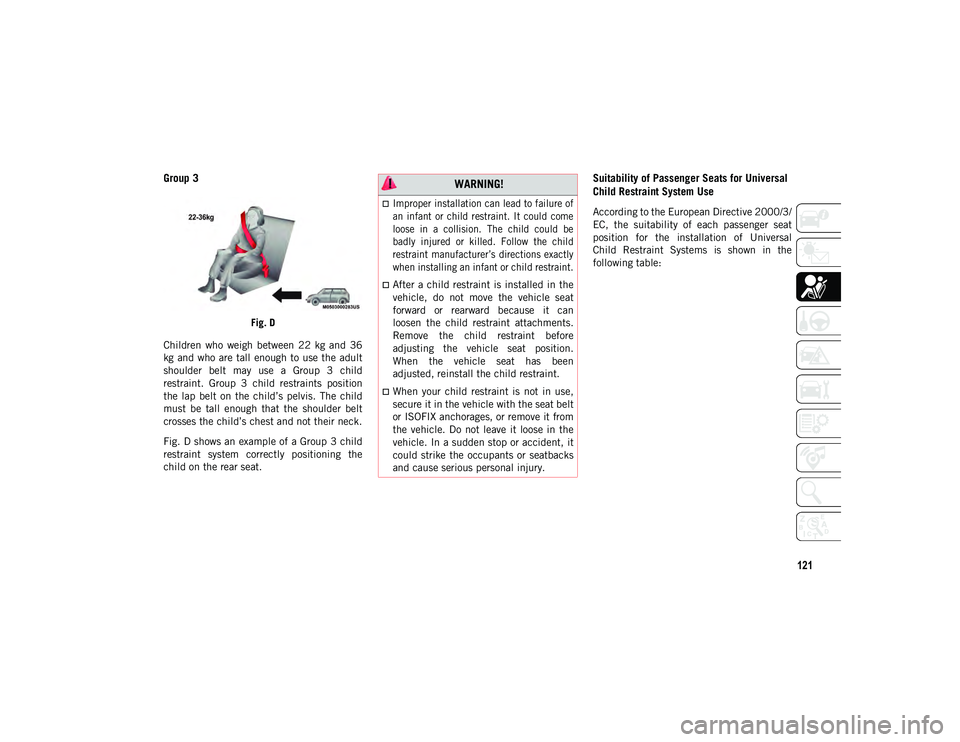
121
Group 3
Fig. D
Children who weigh between 22 kg and 36
kg and who are tall enough to use the adult
shoulder belt may use a Group 3 child
restraint. Group 3 child restraints position
the lap belt on the child’s pelvis. The child
must be tall enough that the shoulder belt
crosses the child’s chest and not their neck.
Fig. D shows an example of a Group 3 child
restraint system correctly positioning the
child on the rear seat.
Suitability of Passenger Seats for Universal
Child Restraint System Use
According to the European Directive 2000/3/
EC, the suitability of each passenger seat
position for the installation of Universal
Child Restraint Systems is shown in the
following table:
WARNING!
Improper installation can lead to failure of
an infant or child restraint. It could come
loose in a collision. The child could be
badly injured or killed. Follow the child
restraint manufacturer’s directions exactly
when installing an infant or child restraint.
After a child restraint is installed in the
vehicle, do not move the vehicle seat
forward or rearward because it can
loosen the child restraint attachments.
Remove the child restraint before
adjusting the vehicle seat position.
When the vehicle seat has been
adjusted, reinstall the child restraint.
When your child restraint is not in use,
secure it in the vehicle with the seat belt
or ISOFIX anchorages, or remove it from
the vehicle. Do not leave it loose in the
vehicle. In a sudden stop or accident, it
could strike the occupants or seatbacks
and cause serious personal injury.
2020_JEEP_JL_WRANGLER_UG_RHD_UK.book Page 121
Page 124 of 330
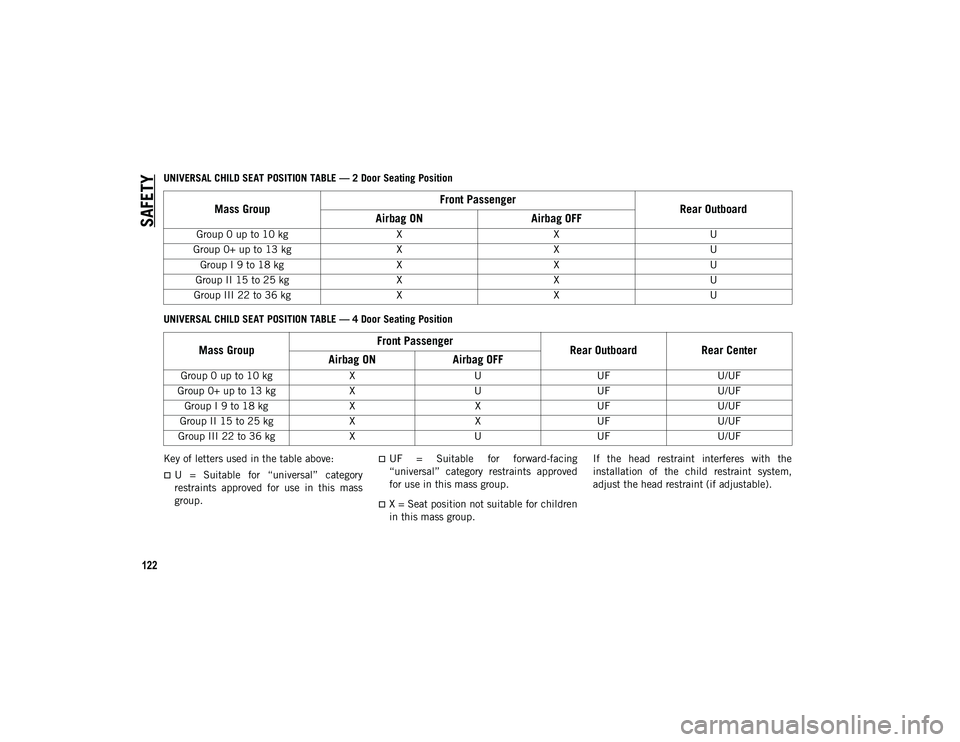
SAFETY
122
UNIVERSAL CHILD SEAT POSITION TABLE — 2 Door Seating Position
UNIVERSAL CHILD SEAT POSITION TABLE — 4 Door Seating Position
Key of letters used in the table above:
U = Suitable for “universal” category
restraints approved for use in this mass
group.
UF = Suitable for forward-facing
“universal” category restraints approved
for use in this mass group.
X = Seat position not suitable for children
in this mass group.If the head restraint interferes with the
installation of the child restraint system,
adjust the head restraint (if adjustable).
Mass Group
Front Passenger
Rear Outboard
Airbag ON Airbag OFF
Group 0 up to 10 kg XXU
Group 0+ up to 13 kg XXU
Group I 9 to 18 kg XXU
Group II 15 to 25 kg XXU
Group III 22 to 36 kg XXU
Mass Group Front Passenger
Rear OutboardRear Center
Airbag ON Airbag OFF
Group 0 up to 10 kg XUUFU/UF
Group 0+ up to 13 kg XUUFU/UF
Group I 9 to 18 kg XXUFU/UF
Group II 15 to 25 kg XXUFU/UF
Group III 22 to 36 kg XUUFU/UF
2020_JEEP_JL_WRANGLER_UG_RHD_UK.book Page 122
Page 125 of 330
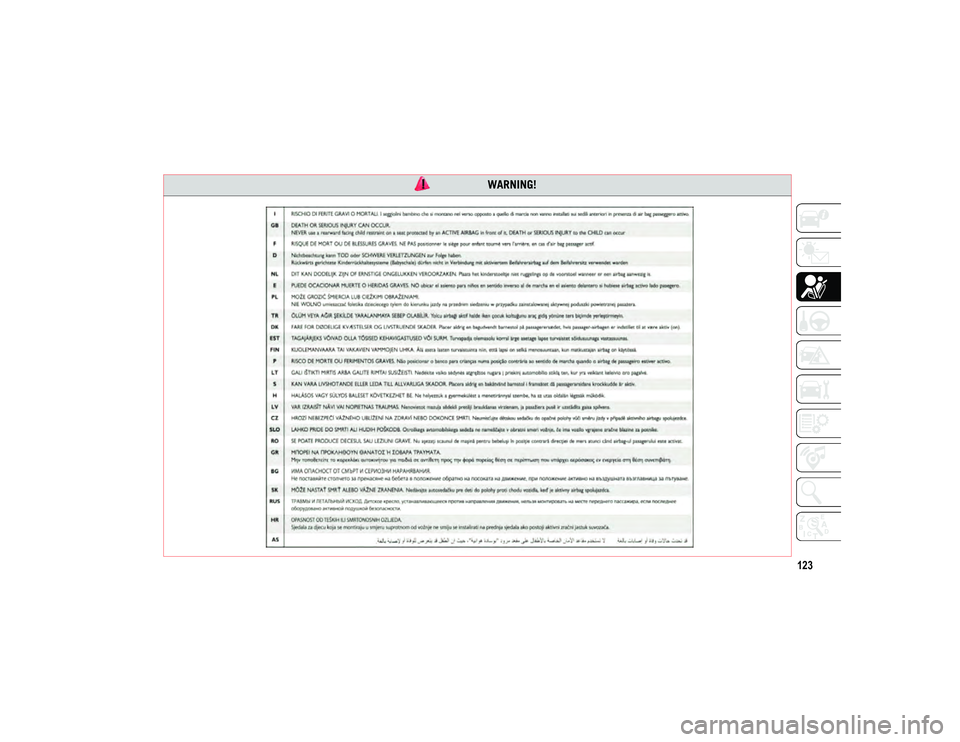
123
WARNING!
2020_JEEP_JL_WRANGLER_UG_RHD_UK.book Page 123
Page 126 of 330
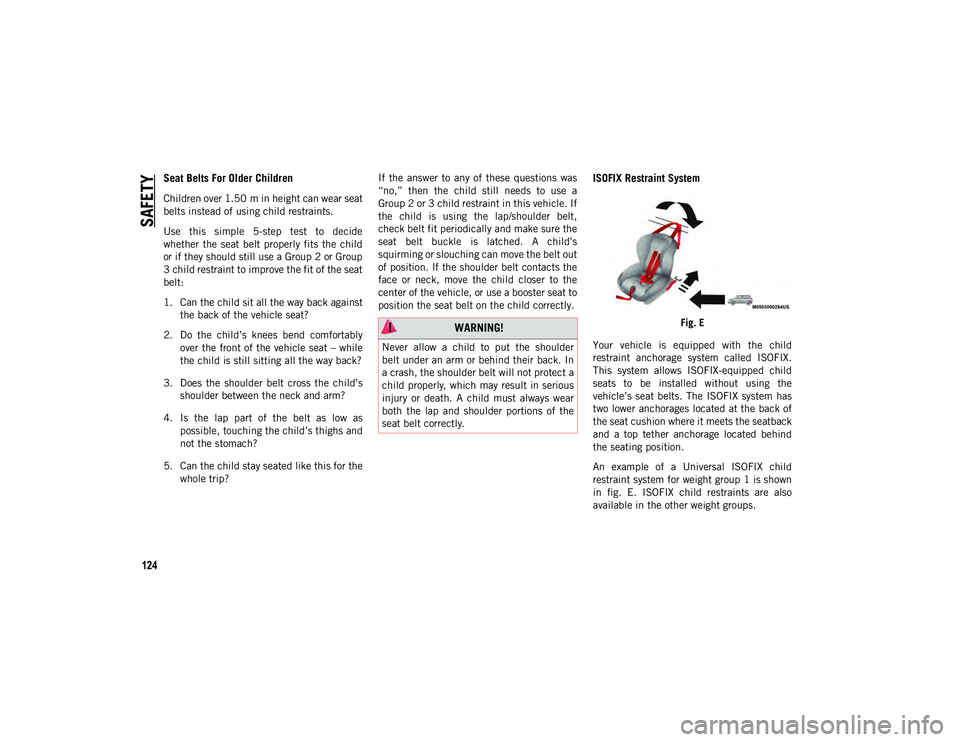
SAFETY
124
Seat Belts For Older Children
Children over 1.50 m in height can wear seat
belts instead of using child restraints.
Use this simple 5-step test to decide
whether the seat belt properly fits the child
or if they should still use a Group 2 or Group
3 child restraint to improve the fit of the seat
belt:
1. Can the child sit all the way back againstthe back of the vehicle seat?
2. Do the child’s knees bend comfortably over the front of the vehicle seat – while
the child is still sitting all the way back?
3. Does the shoulder belt cross the child’s shoulder between the neck and arm?
4. Is the lap part of the belt as low as possible, touching the child’s thighs and
not the stomach?
5. Can the child stay seated like this for the whole trip? If the answer to any of these questions was
“no,” then the child still needs to use a
Group 2 or 3 child restraint in this vehicle. If
the child is using the lap/shoulder belt,
check belt fit periodically and make sure the
seat belt buckle is latched. A child’s
squirming or slouching can move the belt out
of position. If the shoulder belt contacts the
face or neck, move the child closer to the
center of the vehicle, or use a booster seat to
position the seat belt on the child correctly.
ISOFIX Restraint System
Fig. E
Your vehicle is equipped with the child
restraint anchorage system called ISOFIX.
This system allows ISOFIX-equipped child
seats to be installed without using the
vehicle’s seat belts. The ISOFIX system has
two lower anchorages located at the back of
the seat cushion where it meets the seatback
and a top tether anchorage located behind
the seating position.
An example of a Universal ISOFIX child
restraint system for weight group 1 is shown
in fig. E. ISOFIX child restraints are also
available in the other weight groups. WARNING!
Never allow a child to put the shoulder
belt under an arm or behind their back. In
a crash, the shoulder belt will not protect a
child properly, which may result in serious
injury or death. A child must always wear
both the lap and shoulder portions of the
seat belt correctly.
2020_JEEP_JL_WRANGLER_UG_RHD_UK.book Page 124
Page 127 of 330
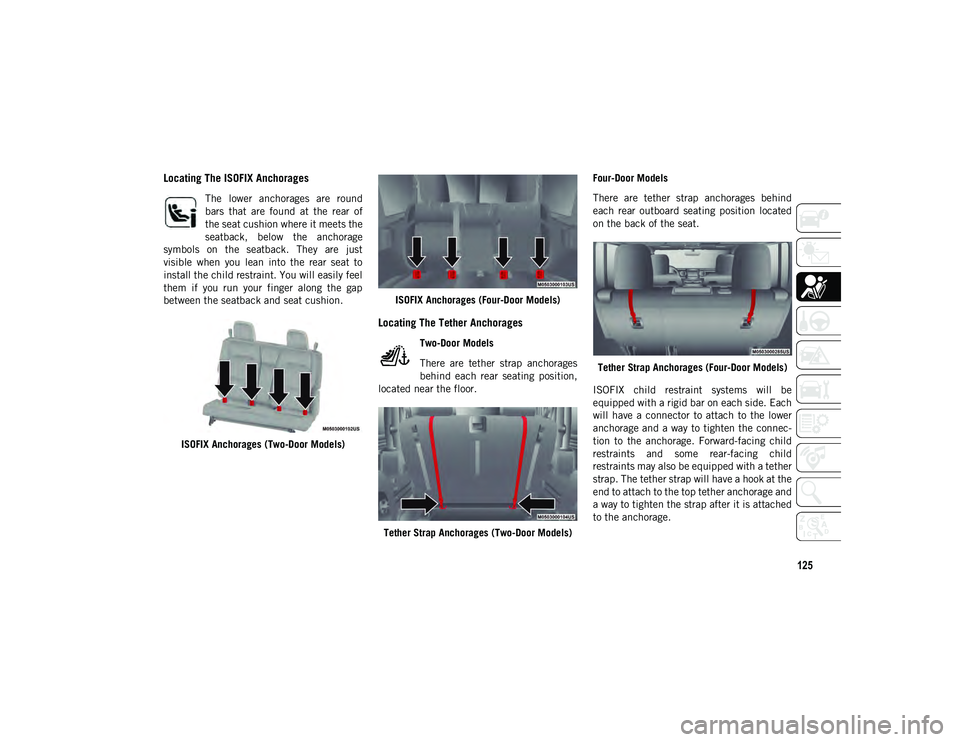
125
Locating The ISOFIX Anchorages
The lower anchorages are round
bars that are found at the rear of
the seat cushion where it meets the
seatback, below the anchorage
symbols on the seatback. They are just
visible when you lean into the rear seat to
install the child restraint. You will easily feel
them if you run your finger along the gap
between the seatback and seat cushion.
ISOFIX Anchorages (Two-Door Models) ISOFIX Anchorages (Four-Door Models)
Locating The Tether Anchorages
Two-Door Models
There are tether strap anchorages
behind each rear seating position,
located near the floor.
Tether Strap Anchorages (Two-Door Models) Four-Door Models
There are tether strap anchorages behind
each rear outboard seating position located
on the back of the seat.
Tether Strap Anchorages (Four-Door Models)
ISOFIX child restraint systems will be
equipped with a rigid bar on each side. Each
will have a connector to attach to the lower
anchorage and a way to tighten the connec -
tion to the anchorage. Forward-facing child
restraints and some rear-facing child
restraints may also be equipped with a tether
strap. The tether strap will have a hook at the
end to attach to the top tether anchorage and
a way to tighten the strap after it is attached
to the anchorage.
2020_JEEP_JL_WRANGLER_UG_RHD_UK.book Page 125
Page 128 of 330
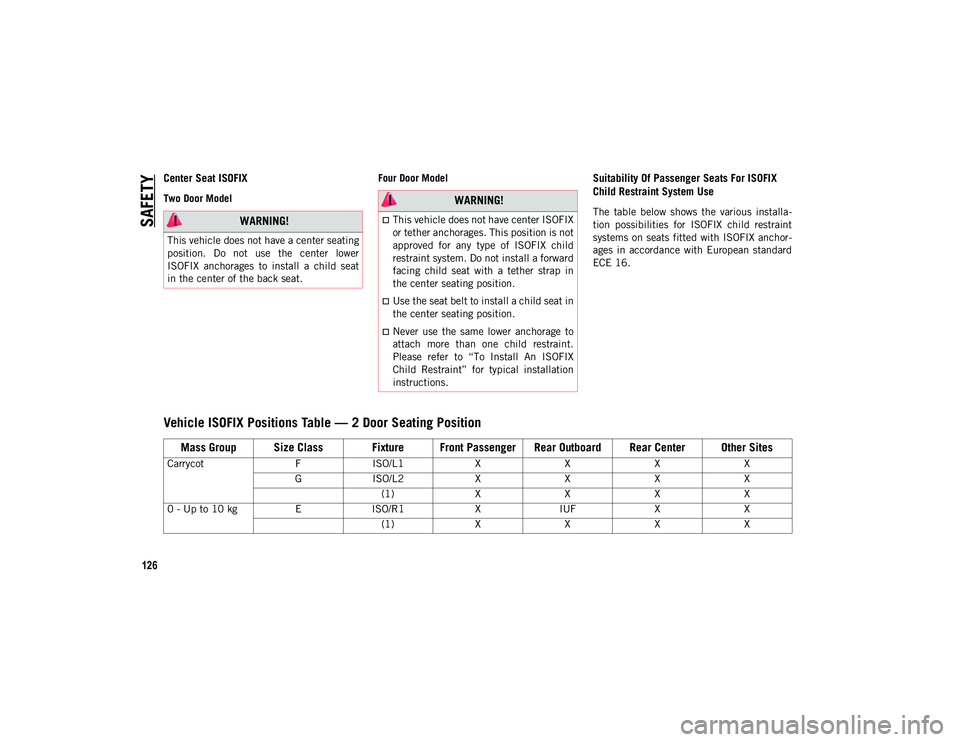
SAFETY
126
Center Seat ISOFIX
Two Door ModelFour Door Model
Suitability Of Passenger Seats For ISOFIX
Child Restraint System Use
The table below shows the various installa
-
tion possibilities for ISOFIX child restraint
systems on seats fitted with ISOFIX anchor -
ages in accordance with European standard
ECE 16. WARNING!
This vehicle does not have a center seating
position. Do not use the center lower
ISOFIX anchorages to install a child seat
in the center of the back seat.
WARNING!
This vehicle does not have center ISOFIX
or tether anchorages. This position is not
approved for any type of ISOFIX child
restraint system. Do not install a forward
facing child seat with a tether strap in
the center seating position.
Use the seat belt to install a child seat in
the center seating position.
Never use the same lower anchorage to
attach more than one child restraint.
Please refer to “To Install An ISOFIX
Child Restraint” for typical installation
instructions.
Vehicle ISOFIX Positions Table — 2 Door Seating Position
Mass Group Size Class Fixture Front Passenger Rear Outboard Rear Center Other Sites
Carrycot FISO/L1 XXXX
G ISO/L2 XXXX
(1) XXXX
0 - Up to 10 kg EISO/R1 XIUF XX
(1) XXXX
2020_JEEP_JL_WRANGLER_UG_RHD_UK.book Page 126
Page 129 of 330
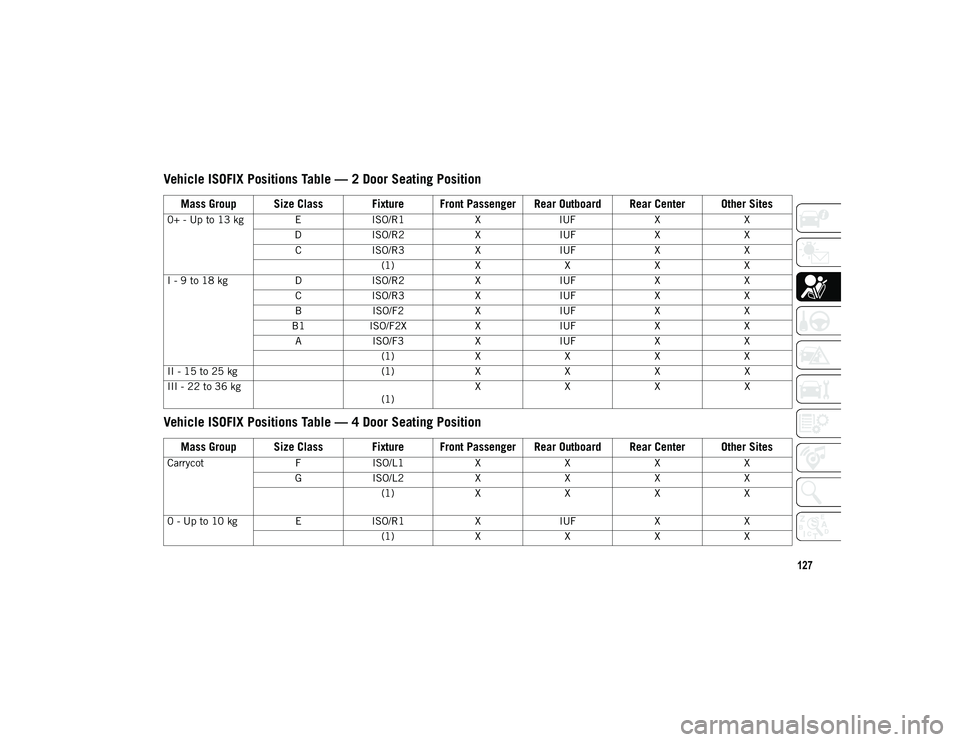
127
0+ - Up to 13 kg EISO/R1XIUF XX
D ISO/R2 XIUF XX
C ISO/R3 XIUF XX
(1) XXXX
I - 9 to 18 kg DISO/R2 XIUF XX
C ISO/R3 XIUF XX
B ISO/F2 XIUF XX
B1 ISO/F2X XIUF XX
A ISO/F3 XIUF XX
(1) XXXX
II - 15 to 25 kg (1)XXXX
III - 22 to 36 kg
(1) X
XXX
Vehicle ISOFIX Positions Table — 4 Door Seating Position
Mass Group Size Class Fixture Front Passenger Rear Outboard Rear Center Other Sites
Carrycot FISO/L1 XXXX
G ISO/L2 XXXX
(1) XXXX
0 - Up to 10 kg EISO/R1 XIUF XX
(1) XXXX
Vehicle ISOFIX Positions Table — 2 Door Seating Position
Mass Group Size Class Fixture Front Passenger Rear Outboard Rear Center Other Sites
2020_JEEP_JL_WRANGLER_UG_RHD_UK.book Page 127
Page 130 of 330
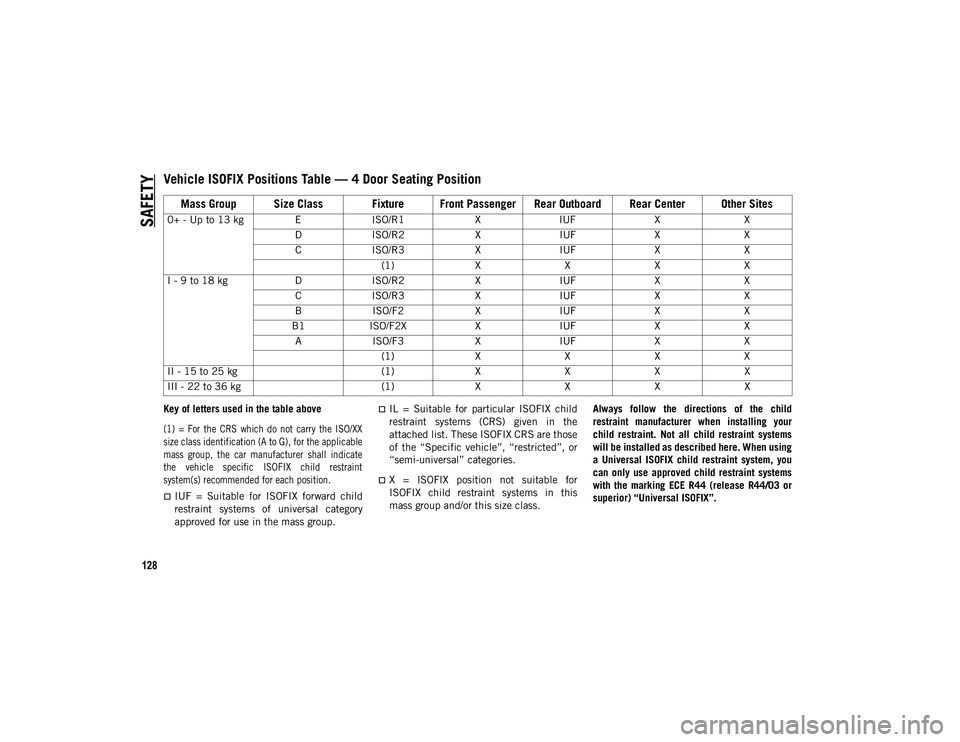
SAFETY
128
Key of letters used in the table above
(1) = For the CRS which do not carry the ISO/XX
size class identification (A to G), for the applicable
mass group, the car manufacturer shall indicate
the vehicle specific ISOFIX child restraint
system(s) recommended for each position.
IUF = Suitable for ISOFIX forward child
restraint systems of universal category
approved for use in the mass group.
IL = Suitable for particular ISOFIX child
restraint systems (CRS) given in the
attached list. These ISOFIX CRS are those
of the “Specific vehicle”, “restricted”, or
“semi-universal” categories.
X = ISOFIX position not suitable for
ISOFIX child restraint systems in this
mass group and/or this size class.Always follow the directions of the child
restraint manufacturer when installing your
child restraint. Not all child restraint systems
will be installed as described here. When using
a Universal ISOFIX child restraint system, you
can only use approved child restraint systems
with the marking ECE R44 (release R44/03 or
superior) “Universal ISOFIX”.
0+ - Up to 13 kg E
ISO/R1XIUF XX
D ISO/R2 XIUF XX
C ISO/R3 XIUF XX
(1) XXXX
I - 9 to 18 kg DISO/R2 XIUF XX
C ISO/R3 XIUF XX
B ISO/F2 XIUF XX
B1 ISO/F2X XIUF XX
A ISO/F3 XIUF XX
(1) XXXX
II - 15 to 25 kg (1)XXXX
III - 22 to 36 kg (1)XXXX
Vehicle ISOFIX Positions Table — 4 Door Seating Position
Mass Group Size Class Fixture Front Passenger Rear Outboard Rear Center Other Sites
2020_JEEP_JL_WRANGLER_UG_RHD_UK.book Page 128